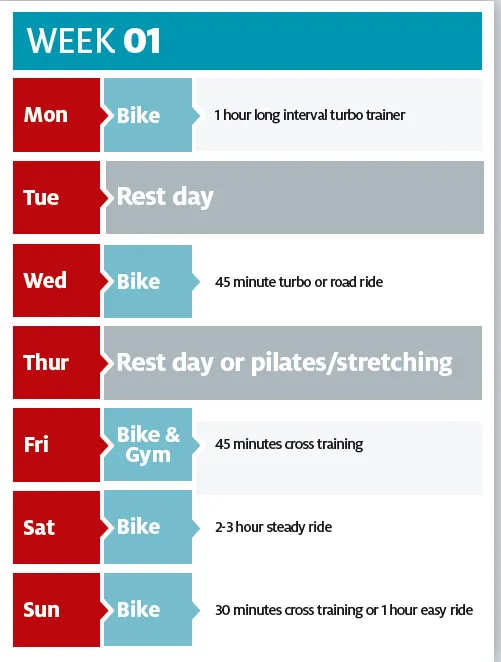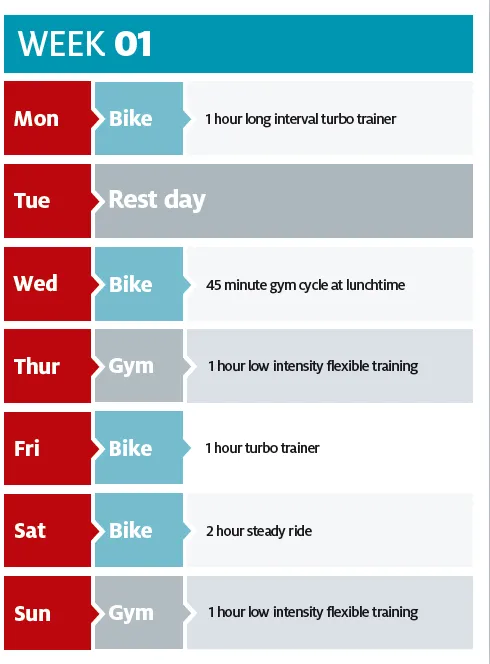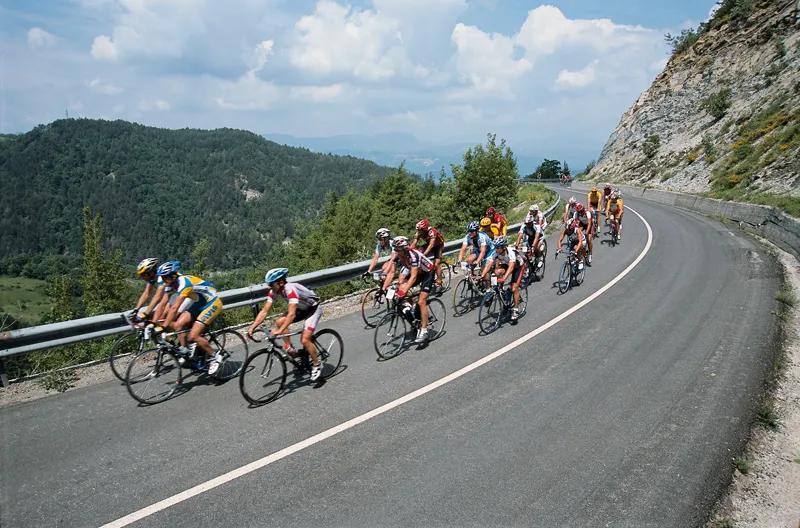Summer is coming, and with it the promise of epic rides and big events. If 2011 is going to be ‘your year’, the time to start making things happen, says cycling coach Chris Ford, of CycleActive, is now.
It’s easy to delay when the days are short and the nights still freezing, but don’t. Training is just as much about thought and preparation as it is about physical effort. Anyone with a ‘brawn over brains’ approach is likely to overtrain, overstrain and end the year disappointed.
This first feature looks at how to kickstart your training, with a focus on three different groups with three different needs. The goals may be similar but we’ve looked at how you can flex your programme to fit with your lifestyle, your current fitness and your target event. For each group we’ve designed a 12-week training plan, to give you a framework for your event preparation. In this issue we’re looking at weeks 1-4, the pre-season training period. Good luck!
10 steps to success
1 Choose a goal
Training needs a goal, something to focus the mind and motivate the soul. Like all objectives the final goal ought to be realistic and specific – for novices this may be a distance event you want to complete in mid-summer, for enthusiasts it may be a time you want to achieve on an event you’ve tackled before, or a first attempt at the Etape du Tour. If you’re new to events you could aim for a 50-mile ride, a charity challenge or audax events from 50km to 400km.
2 Set targets
Nobody scales Everest without considering the camps they need to reach, and when they need to reach them. Once your goal is set, consider some targets to aim for along the way – an interim event, a big ride you’ve always wanted to conquer or some personal hurdle you need to overcome as part of the whole process. The aim of these is to show you how you are improving. It’s all about showing yourself that you’re getting fitter.
3 Ride energy
If you’re aiming for a big ride in hot conditions you need to be able to refuel and rehydrate effectively. This almost certainly means using some form of sports drink, bars or gels. Now is the time to start experimenting with them, on rides, on an empty stomach. Don’t rely too much on reviews or recommendations – if it upsets your system, it won’t work for you.
The science of fuel and hydration is complex but if you consider two key facts – 1) your body only stores enough glycogen in the muscles for about 40 minutes of sustained workout, and 2) your performance drops by about 20 percent for a two percent drop in body hydration levels – you can see why staying fuelled and hydrated is critical to big ride success.
4 Think diet
Scientists used to believe that every cell in your body replaced itself every seven years, but more recent studies suggest it’s actually every year. All you’re made of is the food you eat, the water you drink and a bit of sunshine. If your diet is unhealthy when you are training you will not get the benefit of the hard work you put in – you need to have the right nutrients in your system to allow your body to sustain itself, to develop new capabilities, and to resist illness.
5 Stretch
Get to grips with post-ride stretching to maintain your muscles and reduce the risk of injury. Be sure to include good stretching of the glutes after every training session to help avoid IT band problems, which often result in severe knee pain that can throw your training off for weeks. Also stretch your pecs to balance out the constant shortening effect of being curved over your bike, as well as a full range of leg and hip stretches. Use a good book or find a pilates class and learn from an expert.
6 Bike prep
Bike setup is critical if you’re riding for hours, so if you have a new bike, or some discomfort on your existing bike after an hour or more, get it sorted. Your saddle height needs to be such that your knee remains slightly flexed at the bottom of the pedal A good local bike shop will advise you and provide the right parts to change your fit.
7 Sleep
Much of your training will actually take place at night. You may put your body under strain during a big training ride, but it’s at night that the post-ride fuel is used to develop your muscles. If you’re a late night TV junkie, buy a recorder and get to bed. Some people say that if you cannot sleep for thinking about things, write a list to get it out of your mind and onto paper. Others say allow yourself 30 minutes and if you’re not asleep, get up, have a little walk about, then go back to bed and try again. Hopefully just being on the bike so much will make you tired enough to want more sleep!
8 Plan around obstacles
Life is full of commitments that can take you away from your bike, gym and training for a week or more. Try to spot these now, think about how to cross-train through them, and then they won’t become the cause of stress later.
9 Mental conditioning
The four Cs of psychological coaching are Confidence, Commitment, Control and Concentration. Critically think about how you hold up mentally during a big event, and in the training time before it – there are simple techniques to improve each of these. Good target setting can help build confidence as you can see clear improvements on the path to your event; a way to build mental control when you're in a challenging situation is by using positive self talk.
Focus on the things you can control (keep spinning, look forwards, don’t rush, keep spinning…) rather than things you can't (this hill is going on forever, I’ll never be fit enough at this rate, maybe I’ve done enough for today…). This positive mantra that focuses your mind and body on the criteria for success in a task can have a huge impact on your mental control and concentration.
10 Team cohesion
If you’re training with friends then getting the group working together now will help you all to help each other. As well as the riders, you need to get the buy-in now from family, friends and maybe even work colleagues, since you’re about to become less sociable and flexible. If you can do some of the training together, maybe the cross sessions or the long steady rides, it can help morale and add more enjoyment to the whole process.
Training plans
1) Novice
You’ve been riding a bike for a while and stay in reasonable shape, but have never thought about doing an event until now. Normal rides are a commute or a gentle spin for an hour or two on a good weekend. For 2011 you want to get your first sportive completed and enjoy it.
The first four weeks of training are aimed at building your endurance through low intensity workouts. Cross training should be low to moderate intensity if it’s a new activity. This step up from your normal activity levels will require a change in your food, water and sleep. If you start to feel muscle aches two to three days after a workout it's likely that the intensity level was too high.

Week 2 (build): Increase the turbo session and Sunday ride by 15 minutes.
Week 3 (push): Increase again by 15 minutes each.
Week 4 (recover): Return to the level of week 1. If tired, miss the cross session.
2) Enthusiast
You’re a keen and committed road cyclist with some good events to your name. This year you want to step it up – maybe do the Etape or Marmot, or improve a domestic sportive time. You should have maintained base conditioning with some long, steady rides this winter. Now it’s time to increase session frequency and up the intensity to build speed. Turbo and cross sessions can do this with short, sharp cardiovascular intervals.

Week 2 (build): Increase the interval lengths by 1 minute in the turbo session and add 30 minutes to the Saturday ride.
Week 3 (push): Decrease the recovery period in the intervals by a minute and add a further 30 minutes to the Saturday ride.
Week 4 (recover): Return to the level of week 1. Miss the Monday turbo session.
3) Minimalist
You’re fit, enthusiastic and would fit neatly into the enthusiast category if you had the time. But you don’t. Whether it’s work, family or other activities, you simply can't commit to significant hours of training, but you want to do enough targeted work to let you enjoy a good event.
The winter rides may have suffered due to other commitments but it’s time to check the foundations and start to build up aerobic fitness again. At the same time you need to increase the intensity to build your speed, and find creative ways of stealing short sessions of low intensity training time every day.

Week 2 (build):Increase the interval lengths by 1 minute in the turbo session and add 30 minutes to the Saturday ride, if you can.
Week 3 (push): Decrease the recovery period in the intervals by a minute.
Week 4 (recover): Return to the level of week 1. Miss the Monday turbo session.
Understanding your training plan
Our training plans are built around a 12-week run-up to a major event. This is split into four-week phases: Pre, Early and Peak seasons. The increase in activity level happens like a wave, with the level going up over three weeks then dropping back for a recovery week, before moving to the next phase.
Intensity: The intensity level of training is defined as ‘low’, ‘medium’ and ‘high’. In pre-season the focus is still on low intensity work to continue building endurance and in particular increase your aerobic fitness. This is the bedrock of sportive riding – developing heart and lungs so they can efficiently deliver oxygen to your working muscles. At this stage we also introduce some mid intensity work to start developing speed and the ability to sustain that speed.
At mid intensity you're operating just below your anaerobic threshold – the point at which your heart and lungs can no longer keep up with the oxygen your muscles need to function properly. This can be tested scientifically, or you can aim to be working hard enough that conversations are possible but in short sentences only, and you are never getting ‘puffed out’ (start to breathe/blow more rapidly to expel CO2) which is a sign of excessive CO2 production due to anaerobic activity.
Cross training: Cross training is any non-bike exercise and it's useful to ensure that this covers a wide range of muscle groups to keep you in overall good shape. One round-the-world cyclist said that all of his pre-ride training was on core strength, including arms and most of the upper body, because he wanted to avoid strain or injury from so many miles in the saddle. He said he got bike fit once the ride began!
Turbo trainer: Turbo sessions can serve a range of purposes – a standard session is a good low intensity steady ride when the weather is too bad or nights are too dark to go outdoors. Long interval sessions should be about 6-8 minutes at medium intensity followed by an easy spin at low intensity for 4 minutes to recover. With all sessions, aim to maintain a good cadence of 80-100rpm and a smooth, steady cycling rhythm.
Low intensity flexible training: If you have limited time then developing your aerobic system through long workouts is not an option. Instead you need to find one hour a day that you can use effectively to raise your heart rate – it could be a solid hour of rapid walking at lunchtime, a Sunday dog walk, or an extension of your cycle ride home from work. It’s about stealing snippets of time that add up to a real training benefit

